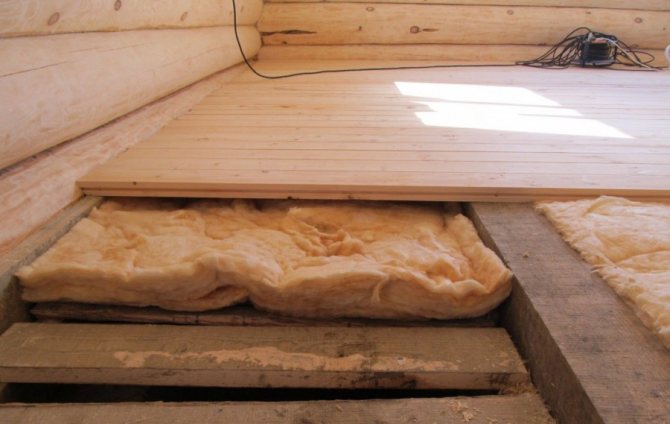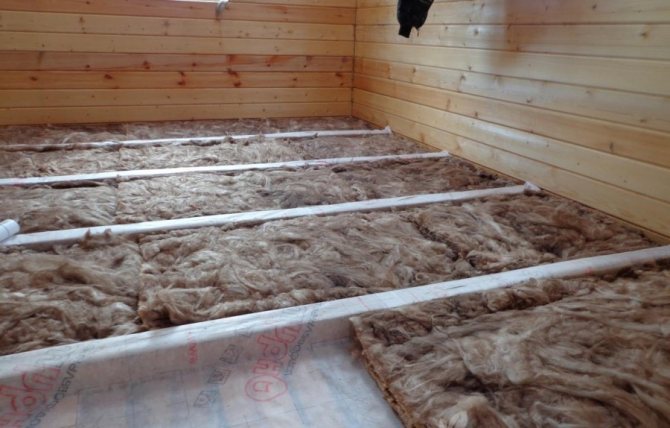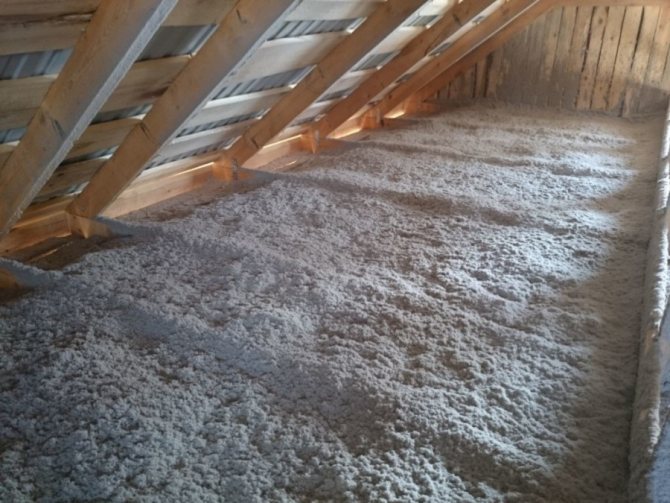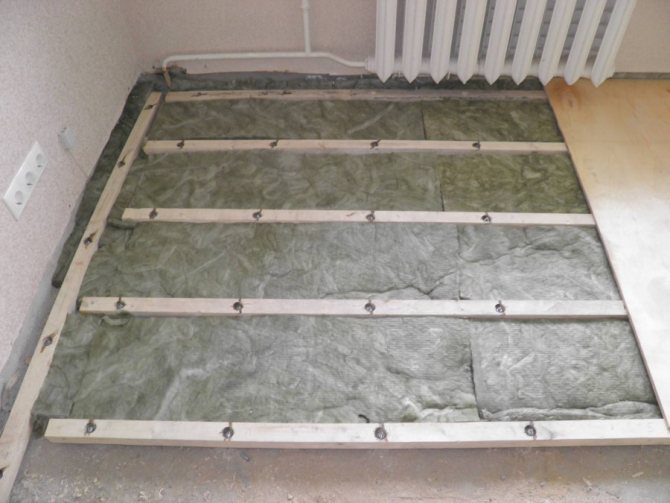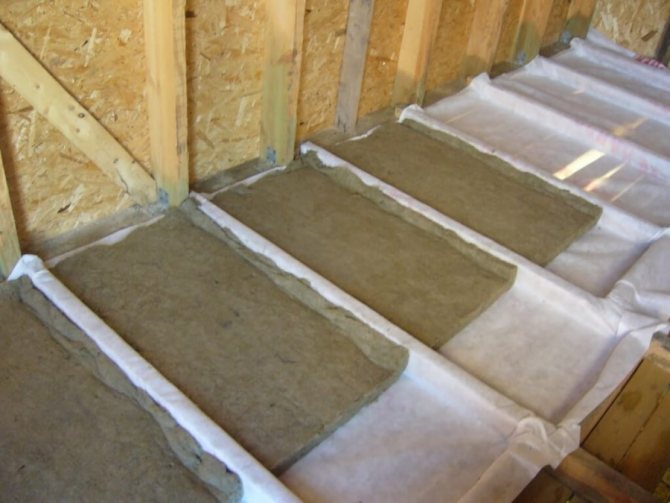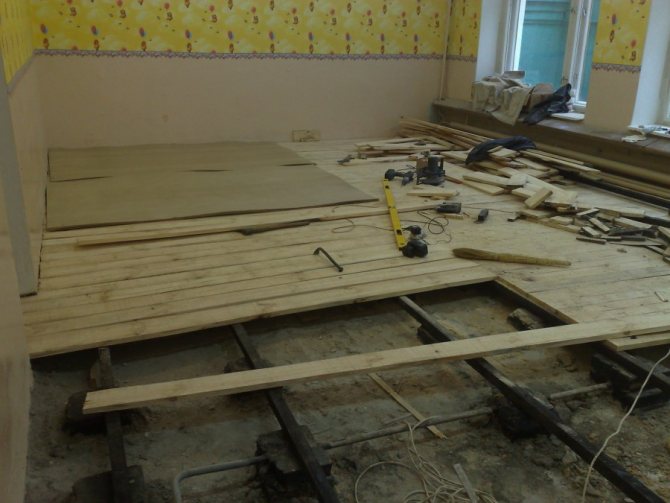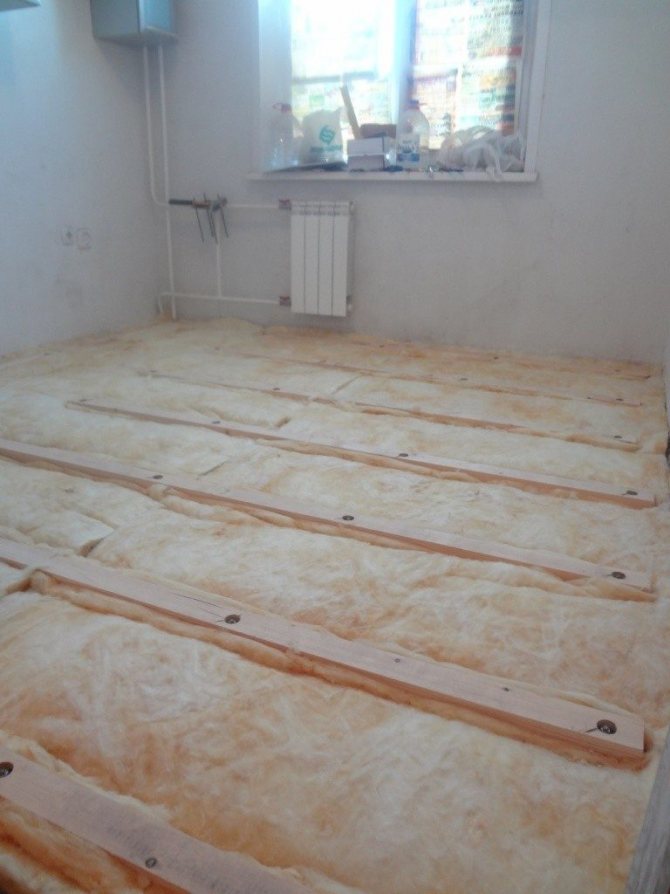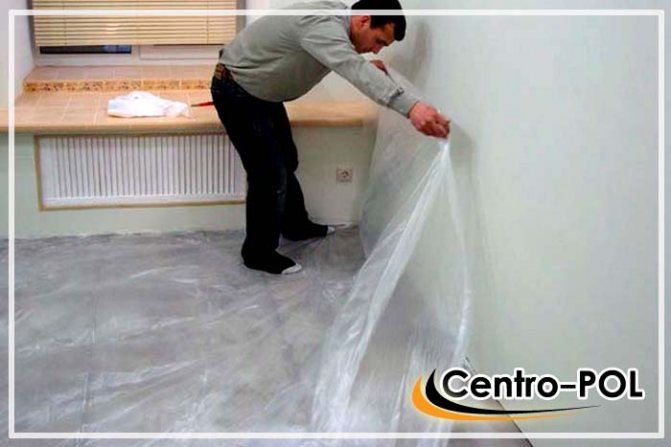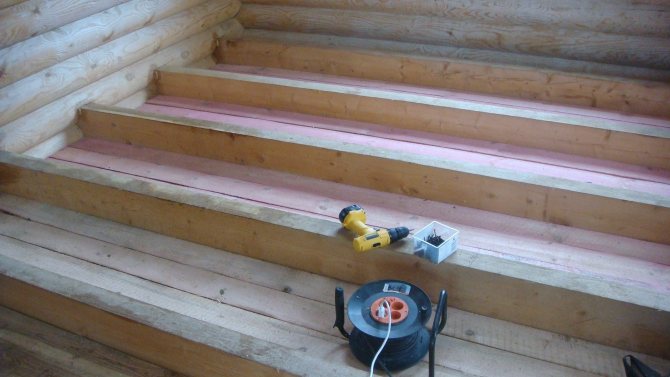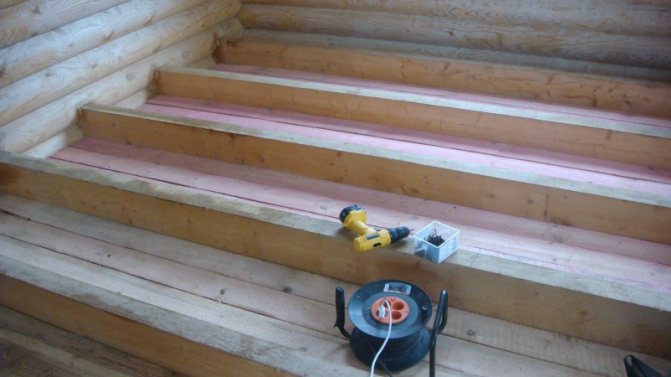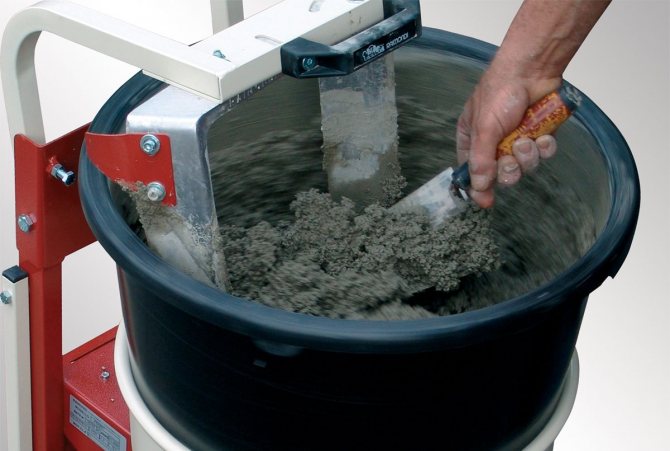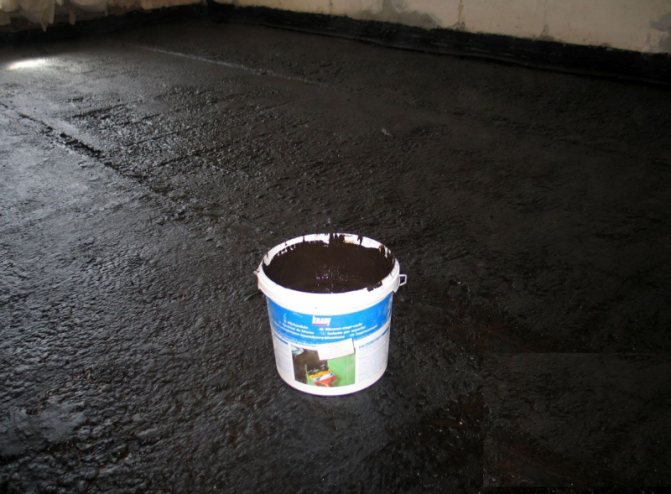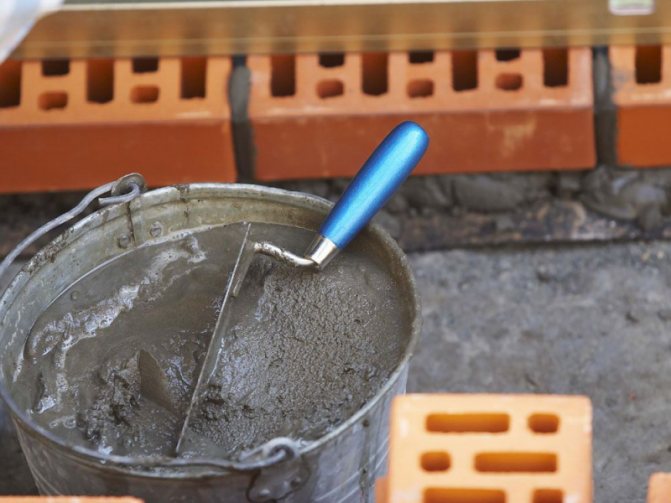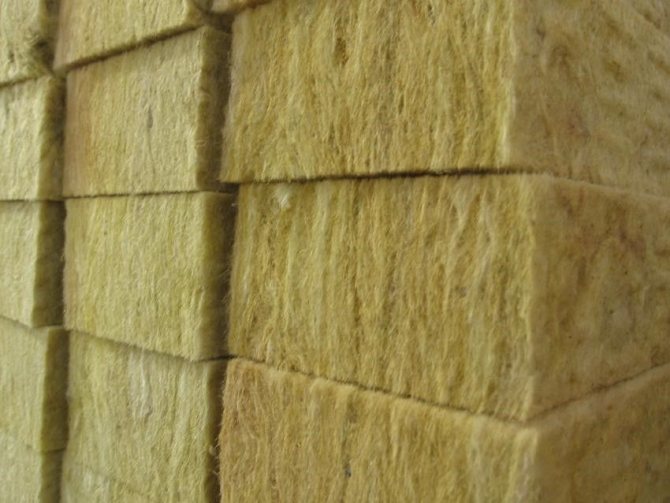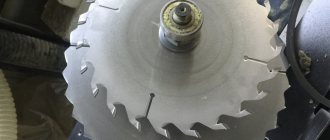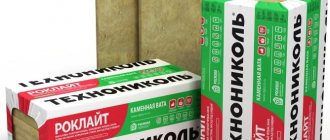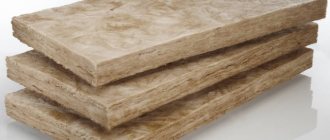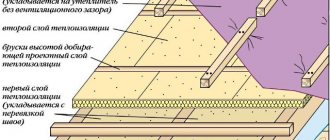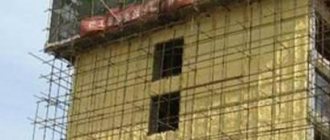The level of comfort of premises for housing is largely due to the temperature on the floor surface. Therefore, thermal insulation is necessary for floors in any house: wooden, brick or reinforced concrete. Thus, two problems can be solved at the same time: comfort is increased and the cost of heating the room is reduced.
The choice of modern materials for thermal insulation is quite wide. Floor insulation with mineral wool is considered one of the most, if not the most popular, thermal insulation options. As a rule, mineral thermal insulation materials are used for insulating floors located on the ground floor and attic.
How is it that the already classic use of mineral wool does not give up its conquered positions?
Mineral wool structure
The canvas is based on molten rocks, glass or slag. According to a special technology, the finest fibers are obtained from them. The molten substance enters the centrifuge, is inflated with air and, under the influence of centrifugal forces, stretches into extremely thin fibers. After deposition in a special chamber, randomly intertwined fibers are combined with binder polymers to form a fabric with a loose porous structure.
Depending on the raw materials used in the manufacture, cotton wool is distinguished:
- glass or glass wool; stone, mainly basalt or from other mountain volcanic rocks; slag, it is based on slags of blast furnaces.
The resulting material may differ in structure, since usually, depending on the raw material, the nuances of the technology used may differ. It happens:
- vertically or horizontally layered; corrugated; spatial.
A few words about the spectrum of application of mineral wool
So, the considered heat insulator is used in such cases:
- insulation of floors;
- plaster-type insulation systems used outside buildings;
- hinged ventilated facades;
- internal wall insulation;
- mineral wool is used as a heat insulator in a multi-layer coating of a flat roof;
- insulation of the attic;
- systems with insulation inside the enclosing structure - we are talking about layered masonry, about three-layer concrete panels.
So that our readers can understand the essence of technology, further subtleties of carrying out some processes will be highlighted.
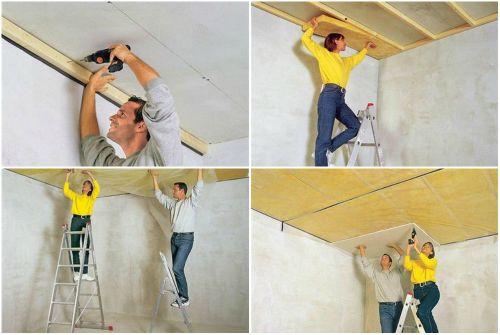
Ceiling insulation with mineral wool
How the roof and ceiling of a house are insulated
Of course, this process rightfully belongs to the category of important, because heat losses through the roof covering, the ceiling are the most significant. First, consider how the roof insulation is carried out:
- the heat insulator is adjusted in size and inserted between the rafters, beams, frame, previously protected with a waterproofing film;
- a small distance is left between the film and the insulation in order to provide ventilation and remove moisture;
- a vapor-proof film is applied to the inner side of the mineral wool - its joints are connected with adhesive tape, and then everything is fixed with the help of wooden slats, nylon cords.
As for the insulation of the ceiling in the attic, it goes like this:
- a vapor barrier layer is laid between the floor beams - glassine is attached to the beams with nails or staples;
- mineral wool is laid on the laid glassine;
- all cracks are blown out with silicone sealant;
- on top of the mineral wool, rough boards are laid, which are nailed to the beams.
In addition, it is possible to insulate the ceiling with mineral wool inside the house.This option is possible only in the case of arranging a suspended or suspended ceiling made of plastic, drywall.
Recommendations for floor insulation with mineral wool
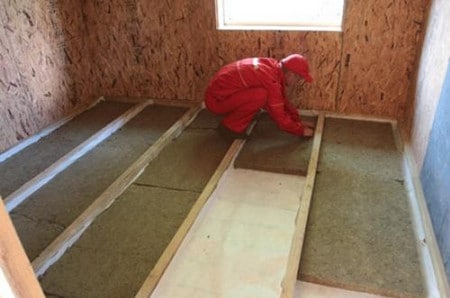

For floor insulation, mineral wool is produced in the form of flexible mats and hard slabs
The entire technological process can be conditionally divided into five stages:
- arrangement of the lower floor cladding - as an option, a solid boardwalk is used if there is no basement in the house, or a sandy base if there is a basement;
- carrying out works related to waterproofing - this process is mandatory, since it is needed to exclude the penetration of water, for example, in the case of abundant melting of snow;
- laying mineral wool slabs - the material is laid close to each other so that not a single gap remains;
- vapor barrier device;
- the final stage is the installation of the finished floor - it is made on bars that provide an air gap between the heat insulator and the floor.
The advantages of insulation
Mineral wool keeps its leadership, thanks to certain advantages:
- The material is non-flammable. It becomes an obstacle to the spread of open fire, therefore, floor insulation with mineral wool is at the same time additional fire protection of the house structure. The declared resistance to high temperatures is striking - over 1000⁰C. Increased thermal insulation properties. This type as a heater with the correct organization of thermal insulation is a guarantee of constantly warm floors. Excellent soundproofing. This is an important factor for the choice, since not every material of this direction on the market can boast such a level of sound insulation. Such indicators make it possible to insulate with mineral wool not only floors, but also ceilings and walls. High frost resistance.
- Resistance to active chemicals and bio-effects. Immunity to rot, fungi and rodent attacks. Vapor permeability. "Breathable" layer of thermal insulation distinguishes mineral wool from other heaters. Ease of installation. Low weight with sufficient thickness and ease of filling any spaces with it greatly facilitate installation work.
- Crease resistance. In dry form, the mineral wool does not change its shape, which also simplifies its installation. Profitability. Low cost, since the manufacturing process itself does not require special costs.
Insulation of concrete floors
To insulate the concrete floor with foam or mineral wool, logs are placed on top of it, between which the insulation is located, and laminate, linoleum or parquet are laid on them.


Often, on top of the insulated floor, a dry screed made of expanded clay and gypsum fiber board is placed on top. Its total thickness is up to 7 cm, 5 cm for expanded clay, and 2 for a GVL slab.
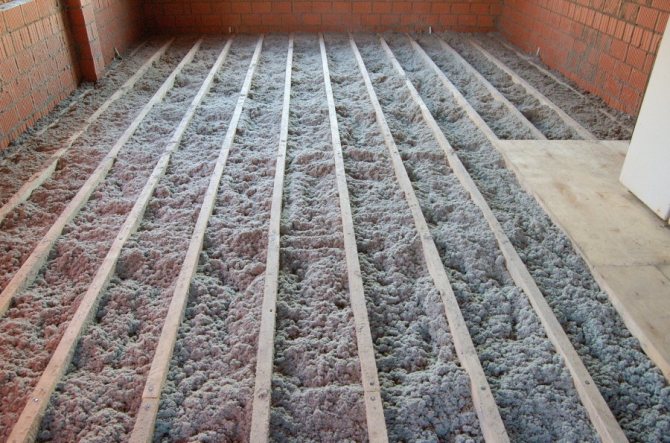

To save space in height, underfloor heating is mounted in the screed, pre-laying a layer of isolon. You can also lay fiberboard sheets on top of concrete, provided that the screed is relatively even, and lay laminate, parquet or linoleum on top of them, the only thing that is not recommended is to put tiles on top of them.
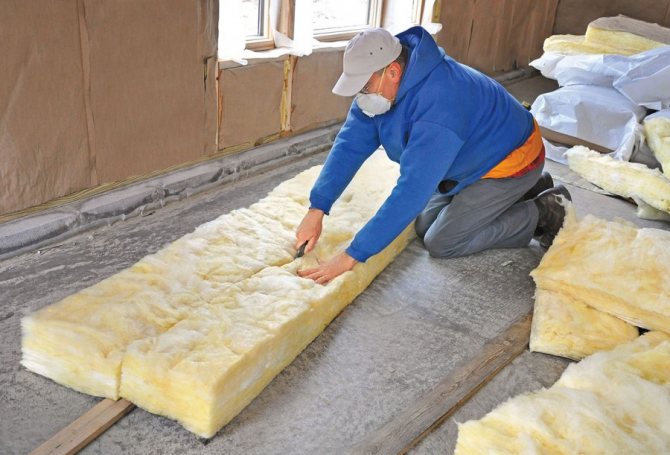

disadvantages
These include an impressive volume in height, since when organizing a frame from a lag, the thickness of the insulation layer is taken into account.
- Moisture resistance is a quality that does not characterize all types of mineral wool. They require waterproofing, since when moisture enters, they shrink and practically lose their positive characteristics. Fiberglass is more water resistant, its water absorption is two times lower, besides, after drying, it does not lose its qualities, however, this material is not very convenient for installation: the glassy structure and flowability of small glass fragments from its layers creates certain inconveniences.Many are confused by the presence of chemical additives such as formaldehyde in the composition of certain types of mineral wool, which can negatively affect human health. Although it should be noted that there is no single conclusion of numerous debates around this topic so far.
However, it is safe to say that stone wool for floor insulation is quite safe. Moreover, it has not only high sound and heat insulating characteristics and increased fire resistance, but also sufficient water-repellent properties, side by side with high resistance to mechanical stress.
Advantages and disadvantages
The leadership of the mineral wool environment of the floor insulation means in the house is due to the following points:
- high class of incombustibility. An insulator of this category is an obstacle to the spread of fire sources. Varieties of the product are characterized as a means of additional fire protection for structures for various purposes. The material is relevant, including when arranging fire hazardous structures. For example, the working temperature range of stone wool varies up to + 1000 ° C;
- low coefficient of thermal conductivity. The fibrous structure provides an air gap that prevents the transfer of thermal energy. Subject to the installation technology, this type of insulation contributes to maintaining a comfortable microclimate in the room;
- high rates of noise reduction. The composition is able to actively resist the propagation of sound waves. Due to the decent characteristics of sound insulation, this insulating agent is applicable in various structures, including a roofing pie, the device of interfloor ceilings or engineering infrastructures in the house;
- frost resistance. The material is not exposed to negative temperatures, it is able to provide maximum protection against heat loss, regardless of the climatic conditions of the area;
- vapor permeability. The composition compares favorably with other insulators by the ability to "breathe";
- inertness to chemical and biological threats. Insulation based on mineral fibers does not react to the effects of active chemical compounds, pathogens;
- ease of installation. It is convenient to fill any volume of space with mineral wool, since the composition has a low weight with sufficient thickness;
- profitability. The material is sold in an affordable segment, which is due to the simplicity of the manufacturing process.


It is convenient to fill any volume of space with mineral wool, as it is lightweight and thick enough
When planning thermal insulation of the floor with mineral wool, you should also know the disadvantages of the resource:
- impressive volume in height. The thickness of the insulation products is of considerable importance when organizing the frame from wooden logs, this argument negatively affects the overall height of the floor structure;
- exposure to moisture. Not all varieties of mineral wool have moisture resistance properties. For example, glass wool and slag wool lose functionality under the influence of a humid environment. Compositions of volcanic rocks - basalt - are highly resistant to moisture;
- certain difficulties in installation. To work with glass wool and slag wool, you must use special clothing and accessories. It is required to exclude direct contact with the composition of small particles with sharp ends, which can affect the skin, respiratory tract and eyes.
A big minus in the piggy bank is the insecurity of certain types of mineral wool due to the presence of chemical components in the composition. Under the influence of high temperatures, the release of compounds harmful to health and the environment is observed. At the same time, the basalt variety of mineral insulation is quite safe and is used when arranging the floor and other structures in the house.
Resources based on volcanic rock are characterized as effective heat and sound insulating means.In addition, the stone insulator provides high fire resistance, resistance to mechanical stress and moisture. The only drawback of basalt insulation is the relative high cost compared to slag and fiberglass.
Types of mineral wool for floor insulation
Minvata is produced in the form:
- rolls;
- solid slab, they are more often used when insulating floors on the ground or
- flexible mat.
- A flexible mat made of water-repellent mineral wool is covered (laminated) with perforated kraft paper on one side. It is laid so that the laminated side is facing in the direction of the room to be insulated. Plates are also made on the basis of a hydrophobized material, and their sides have different rigidity. The stiffer side should be facing upwards when laying the boards. To avoid mistakes during installation, it is marked in blue. These slabs are predominantly used for single-layer thermal insulation along the ground.
Features of work on floor insulation with mineral wool
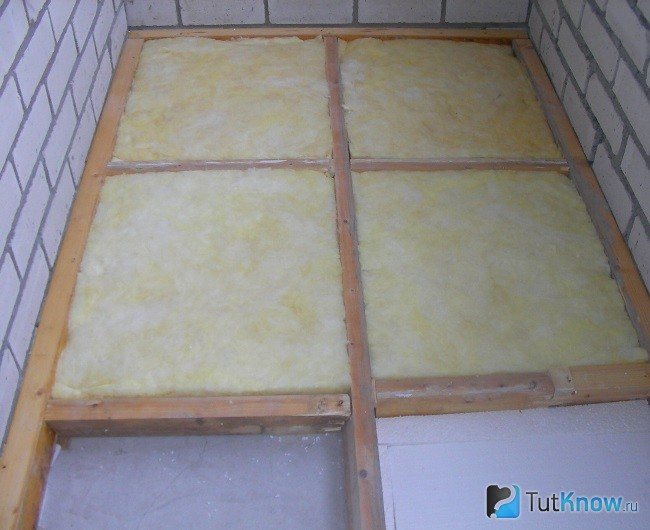

The insulator is a material of a fibrous structure on a synthetic basis, which is saturated with an inert gas that perfectly retains heat. Mineral wool for floor insulation is sold in the form of rolls and slabs of various sizes and densities, which affect the choice of installation method.
The rolls have low rigidity, and a wooden crate is made for them in advance. They are ideal for large areas because the total length of the gaps between the individual parts is minimal. Products are produced in widths of 1.2 and 0.6 m and a maximum length of 10 m. Usually, two layers of roll insulation are laid to ensure an optimal thickness of 100 mm.
Plates are more often than rolls used for laying on the ground. They differ in the presence of hydrophobized components. They have two-sided rigidity: one side is harder, so their installation should be carried out taking into account the manufacturer's requirements. In order not to be mistaken, markings are applied to the surface in blue. They come on sale in packaging, which is enough to cover from 1 to 4 m2 in one layer. The dimensions of the panels are 50 × 100 cm. High-density slabs can be laid without lathing and filled with a screed.
In houses, mineral wool is used in such cases:
- For insulation of floors above a cold basement;
- For heat and sound insulation of interfloor floors;
- To protect the attic floor.
The thickness of the product depends on the climatic conditions and the purpose of the room. The floors of houses in the southern regions and summer cottages, which are used only in summer, are covered with samples of 50 mm thickness.
The same materials are used on the floors. This is due to the need to maintain the height of the room and the low temperature requirements in these places. In country houses, the thickness of mineral wool for floor insulation can reach 200 mm.
The product has a harmful effect on humans due to the presence of fine fibers that irritate the skin. When working, you should adhere to the elementary safety rules:
- Avoid contact with the material when laying. Wear goggles, gloves, long sleeves, and a respirator. Change after work.
- Keep rolls and slabs out of the reach of children.
- Prevent fibers from spreading throughout the apartment. After warming, immediately clean the place of work.
Mineral wool absorbs moisture well, therefore, to protect it from getting wet, the composition of the insulation "cake" must necessarily include hydro and vapor barrier films.
How to insulate the floor: step-by-step implementation
The whole process of installing floor insulation can be divided into several main stages:
- surface preparation. The structure of the concrete pavement should not contain cracks, large level differences. If they are available, work is carried out to eliminate such defects - filling the leveling layer and filling with the repair composition of cracks and chips.waterproofing; laying insulation. After calculating the required amount of insulation, you can start installing it. It must fit evenly over the entire surface of the subfloor. One of the advantages of a basalt heat insulator is that it does not have to be fixed to the floor surface. When laid evenly, the weight of the top cement screed will provide a proper pressure rating. vapor barrier; subfloor under the topcoat or reinforced screed. Before pouring a protective concrete layer, a vapor-permeable film must be installed. Complete waterproofing can lead to moisture concentration between the heat insulator and the screed. The properties of such a film are the ability to pass water molecules, preventing significant passage of moisture. This will protect the concrete surface from the damaging effects of moisture and ensure its removal from the concrete structure through a layer of mineral wool. After installing the concrete screed, the main decorative coating can be installed.
How to properly insulate walls with mineral wool
Let's talk first about what can put all your work down the drain.
Mounting errors of mineral wool boards
- Lack of surface preparation. It should be flat, clean and treated with an antiseptic (if it is a tree).
- Carrying out work during precipitation or leaving finished work without rain protection.
- Insufficient adhesive application. Correct when it is distributed over the entire surface, including the perimeter. The most suitable adhesive is polyurethane foam or dry mix. The first products are easier and faster to work with, but slightly more expensive. Both products are resistant to external influences and guarantee good adhesion.
- Unfilled seams between insulation parts. They can only be closed with inserts of the same material. The maximum clearance is 2 mm.
- Intersection of slabs in window and door corners. There should be no joint in these places.
- Lack of mechanical fasteners. Anchors and dowels are used as additional connections for heavy sheets. The optimal amount is 3-4 pieces per piece (two at the corners, 1 or 2 in the center).
- Smooth mounting, joint to joint. Masters advise to install the elements in a checkerboard pattern - this way it is easier to avoid cracks in the structure.
These are the main mistakes people make when doing thermal insulation at home on their own.
Instructions for insulating the walls of the house with mineral wool outside
You will need a metal profile or timber to create the lathing, accompanying tools for building the frame, a knife or saw, fasteners and a membrane film for vapor barrier. There are two methods. Let's consider one of them. The work is carried out in several stages.
- Surface preparation. It is necessary to remove all old layers of plaster and other finishes from it, clean off dirt and mold, carry out processing and remove all irregularities with a primer.
- Installation of the frame. After the primer has dried, mount the guides at a short distance from the facade - about 10-15 cm in increments of 60-100 cm, 1-2 cm less than the width of the block or roll.
- A film is placed under the first layer - the smooth side to the plate and the vapor-absorbing one inside. It is attached with double-sided tape or a stapler.
- The first layer of cotton wool is attached on top. Usually a softer one is chosen so that it hides depressions or bulges if they remain after alignment. Plates are laid from bottom to top, and rolls - from top to bottom.
- Further, more rigid elements are mounted. For reliability, they can be fixed with a construction stapler or mushroom dowels.
- Another layer of vapor barrier is placed on top (the film is not stretched), lathing and cladding.
In the case of fastening under the frame, it is important to know in advance the size of the mineral wool insulation for the walls in order to correctly calculate the distance between the profiles.
Thermal insulation of the floor with mineral wool implies the creation of a complex structure to protect the floor from external influences. A resource with a fibrous structure is distinguished by high heat and sound insulation properties and ease of use. Knowing the features of the material and the installation technology, it is easy to perform the thermal insulation of the floor with mineral wool with your own hands.
Wooden floor
For a wooden floor, the installation technology of basalt insulation is somewhat different from the one described above. The main specificity is the presence of logs on which a wooden decorative covering is installed.
First, a rough plank floor is mounted on the cranial bars. It will serve as the basis for the installation of waterproofing and insulation. Since the load on the surface of this floor will be minimal, you can use boards up to 2 cm thick.
Then you need to install a waterproofing film. It should be located not only on the boards, but also on the logs. Uncovered areas are not allowed. The joints are insulated with special tape. If bituminous material is used as waterproofing, the seams are covered with mastic.
Mineral wool for floor insulation should be located between the logs. It fits snugly against their side surface, preventing gaps.
After checking the absence of gaps and the tight fit of the heat insulator to the surface of the subfloor, you can start installing the vapor barrier film. Installation of a completely sealed material is not allowed - if moisture enters the structure of basalt wool, it must be ensured that it escapes through the vapor barrier layer and the ventilation gap.
The latter is required. For its formation, spacer strips are installed on the surface of the lag, on top of which the main floor covering is attached.
Such floor insulation with mineral wool is optimal. This is especially true for buildings with increased fire safety requirements. Therefore, basalt insulation is most often used for thermal insulation of the floor and walls of baths and saunas.
To effectively insulate the floor in any house or apartment, stone wool is an excellent option. This is one of the types of mineral wool. If you understand the rules for warming the floor with stone wool, carry out all the manipulations with high quality, then the material will last a long time, in accordance with its characteristics.
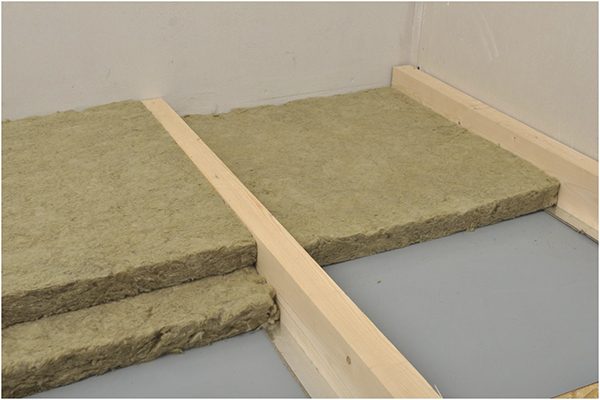

Warming with cotton wool
How to choose mineral wool for insulating a wooden or concrete floor
Today there are many varieties of mineral wool. They differ in composition, thickness and properties. All of them can be divided into three groups.
Glass wool consists of molten glass waste and silicon particles. The particles of this material (hairs) are the longest. Sometimes their size reaches three millimeters. Due to this structure, this type of mineral wool has the following features:
- The fibers adhere tightly, which gives the pieces of mineral wool a special density, for this reason the consumption of raw materials for its production is minimal. Consequently, the price is low. It is used as a heater quite often.
- The second feature is the disadvantage of this type. Since the hairs of glass wool are small pointed sticks, it becomes difficult to work with this material. Particles cling to the fitter's clothing and body, and also enter the eyes and respiratory tract. To prevent such situations, you should work with this material with a respirator, goggles and protective suit.
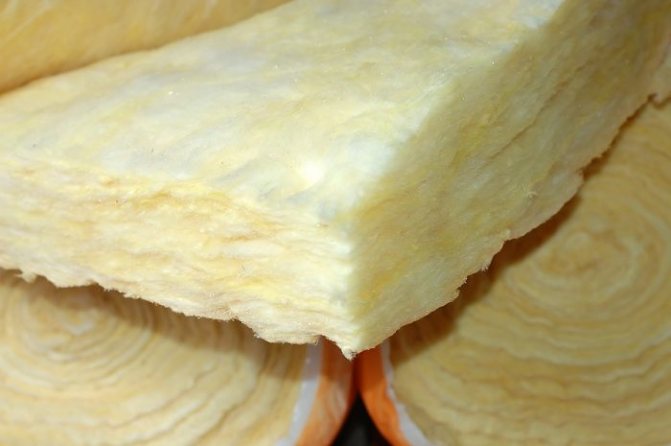

Glass mineral wool
The next type is stone wool. Basalt is the main raw material for its production. The production technology of such heaters is simple, since the composition includes a minimum amount of substances. Particles of this insulation reach a size of up to one and a half millimeters.
Since it has a more rigid adhesion, it is better to use it for insulating vertical surfaces.Due to this feature, stone wool is used for temporary installation.
The stone wool fibers do not take on a pointed shape, which greatly facilitates the installation procedure. The particles have less tenacity, however, it is necessary to use protective equipment in order to avoid unpleasant consequences.
The third type is slag. It consists of blast furnace slag. Its particles are the smallest in comparison with other types of mineral wool. From a technological point of view, the production of this material is complex, which is reflected in the price.


Slag mineral wool
Slag wool has minimal rigidity, therefore it is used mainly for floor insulation. It is difficult to cut, therefore it is used for large-scale insulation, where this process is carried out using special machinery. It is recommended to use protective equipment during installation.
To effectively insulate the floor in any house or apartment, stone wool is an excellent option. This is one of the types of mineral wool. If you understand the rules for warming the floor with stone wool, carry out all the manipulations with high quality, then the material will last a long time, in accordance with its characteristics.
Warming with cotton wool
Features of insulation with stone wool
Cotton wool is made from molten glass, slag, stone rocks. Special processing helps to obtain elongated fibers, which are extracted from the centrifuge under the influence of centrifugal force when the threads are stretched. All elements are deposited in a closed volume. Subsequently, they are woven and additionally fastened with polymers, making up a single canvas. The resulting cotton wool is porous, its inner side is loose.
By the type of the main component of cotton wool, it can be:
- stone (or basalt);
- glass wool;
- slag.
Raw materials differ in structure:
Floor cotton wool is sold in rolls. It is suitable for insulation. To do this, you need to unwind the roll, cut it into the necessary pieces according to the size of the room.
In accordance with the conditions of use, the thickness of the cotton wool is 50 - 200 mm, less often a little more. When material of the required thickness is not commercially available, it is allowed to lay several layers. For example, in the climate of the central part of Russia, usually the insulation layer should be 150 mm - this way you can use 3 layers of cotton wool, 50 mm each.
Before buying basalt wool, you need to pay attention to the following recommendations:
- inspect the packaging - if there are traces of damage on it, when a piece of the material itself is visible, it is better not to buy it, since the cotton wool could get wet and lose its characteristics;
- for a cold first floor, basement, you should choose a material with a thickness of more than 150 mm;
- in a harsh climate, you need to mount two layers of insulation or immediately acquire a two-layer material.
The thickness and density of the product are selected taking into account the climate and the purpose of the room. For relatively warm conditions, 50 mm is enough, and for year-round living, preference is given to a thickness of 200 mm.
Options for floor insulation under the screed


In the basement level, thermal insulation is made from materials that are not subject to moisture absorption
There are several options for installing insulation under a concrete screed. Each of them is applied in individual cases.
- Floor slab. In such designs, it is advisable to use a standard film, which is laid in two layers. This makes it possible to achieve an insulation thickness of 300 microns. Fused bitumen is also used. However, it is not very practical, as it retains all the unevenness of the concrete screed.
- In the basement level. There is usually a basement, garage or cellar under the floor slab. In this case, thermal insulation is made from materials that are not subject to moisture absorption (styrene foam, polystyrene and others).
- Between floors.To prevent heat loss in apartments during the heating season, thermal insulation is performed between floors in layers of concrete screed. For such structures, expanded clay, basalt wool or expanded polystyrene are considered the best options.
Liquid insulation in apartment buildings is practically not used as thermal insulation. It is rational to use it in partitions where pipelines pass, subject to the presence of another insulation.
Advantages and disadvantages of insulation
Insulation with cotton wool is an excellent option for residential and non-residential premises. It is profitable and convenient. Vata makes it possible:
- save on materials when building a house;
- save on work - construction is easier;
- increase the usable space in the room.
The advantages of the material should also include:
- fire resistance - the coating can withstand heating temperatures up to 1000 degrees without losing its qualities;
- minvata is a good sound insulator;
- affordable cost compared to other insulation materials;
- during the operation time, you will not have to change the material;
- ease of the installation process.
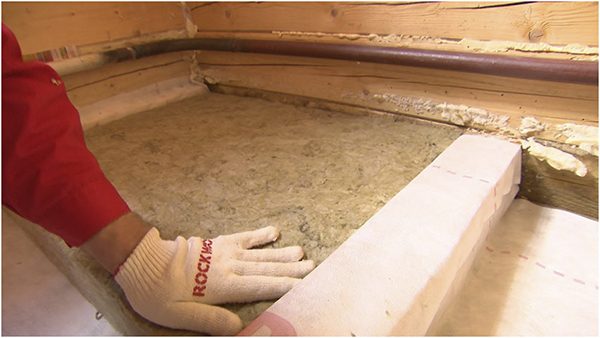

Material characteristics
But mineral wool as a heater has some drawbacks. One of the most important is good absorbency. Because of this, you should not lay the product in rooms with high humidity, and in order to prevent swelling, additional laying of vapor barrier from below and waterproofing from above is required.
Among the main disadvantages are the following:
- Despite the fact that the material is environmentally friendly for the human body, dusty clouds may appear when shaken, it is not advisable that they enter the respiratory system. For this reason, during the installation process, the use of respiratory masks is mandatory. Allergy sufferers and asthmatics should be especially attentive to this issue.
- It is forbidden to use cotton wool in public catering places, but many owners of such establishments neglect this condition.
- Insulation increases the load on the overall structure.
- Cold bridges can form at the joints of the coating. It is better to seal them up additionally to avoid heat leakage from the room.
Materials (edit)
The floor insulation material is selected depending on the characteristics of the room (floor, purpose, humidity, floor material), as well as on the climatic conditions of the area in which the house is located.
The following materials are most often used as insulation:
- Expanded clay - a porous and lightweight material made of fired clay;
- Sawdust - woodworking waste. Some of the cheapest materials. The cost of one laid m2 is almost nothing;
- Polyfoam is a porous polymer material, lightweight and moisture resistant. In addition to thermal insulation properties, it also has excellent waterproofing;
- Penoplex - extruded polystyrene foam - is similar to polystyrene foam, but much more durable and it is believed that it is better in its properties, but has a higher price per m2;
- Mineral wool - mineral fiber mats;
- Glass wool - fiberglass mats, it is generally accepted that its thermal insulation is not much worse than that of mineral wool, but the waterproofing performance is better.
All of these materials have their own advantages and disadvantages. For example, foam, with all its heat and waterproofing properties, has a fairly high fire hazard. Expanded clay is an excellent insulation, but it is quite inconvenient to work with and has unimportant moisture-proof properties, and also has a high cost per m2. And all these materials are still better than simple sawdust, although their use increases the cost of each m2 of flooring.


In mid-latitudes, the most acceptable option is mineral wool
In mid-latitudes, the most acceptable option is mineral wool. This material has long been familiar to everyone, has high heat-shielding and sound-insulating properties.In addition, and importantly, the price of one m2 of mineral wool and, especially, the prices for laying m2 are among the lowest among all building materials. The material is so easy to use that even a non-specialist can lay it with his own hands.
Insulation of floors in a ground floor apartment
Mineral wool is supplied in rolls or mats of certain sizes and thicknesses. Mineral wool laminated with aluminum is also produced. The price of such wool per m2 is higher than that of ordinary wool. However, the cost of laying one m2 does not differ from them. The thickness of this material varies from 50 mm to 200 mm and more, depending on the application. Unlike foam or Penoplek, mineral wool does not require preliminary cutting in shape and size. The roll is simply unwound and the mineral wool is placed in the right place.
Insulation technology
Thermal insulation of the base is carried out in a clear sequence. Even small deviations from the installation steps can cause heat leakage and lead to the loss of mineral wool properties. The stages of installing a floor insulated with basalt wool are as follows:
- Preliminary preparation.
- Installation of waterproofing.
- Installation of thermal insulation.
- Arrangement of a vapor barrier.
- Rough finishing under the topcoat, reinforcement.
- Finish coating.
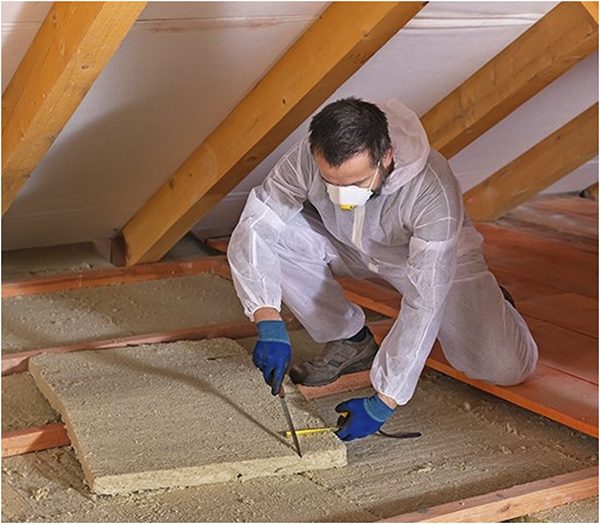

Installation rules and features
Masters recommend adhering to some rules:
- You can use rolled cotton wool, as well as mats or slabs. Plates will significantly facilitate the work, will minimize possible gaps.
- To level the floors, to organize the screed, expanded clay is suitable. It not only makes the surface smoother, but also provides additional thermal insulation.
- There is no need to try to save on thermal insulation by purchasing cheap material in questionable stores. This provokes many problems in the future - too strong shrinkage, loss of qualities, the formation of mold, fungi. It is better to choose mineral wool from reputable manufacturers.
- In order to achieve maximum heat preservation results, you should carefully study the rules for laying, the specifics of the material. This helps to choose the right product, taking into account the characteristics of the room. A good way out is to get advice on choosing from a professional.
Two main methods of laying mineral wool
Free way
It involves laying mineral wool under the structure without the use of additional fasteners. It is usually easier to install rock wool slabs this way. A waterproofing layer is required on the entire surface. Then the mineral wool is very tightly laid between the crate. If you leave gaps, then the insulation may be ineffective due to cold bridges. In this case, the layer thickness also plays an important role. The best option is 20 centimeters.
A vapor barrier is placed on top of the insulation, and then the facade is sheathed with siding.


Mounting with glue or dowels
The insulation is attached directly to the surface. A metal or wooden frame can be used. First, the surface must be cleaned of dirt and dust, primed. You can fix cotton wool with glue, but special dowels are added for reliability. Above it is necessary to lay a reinforcing grid, and then apply plaster.
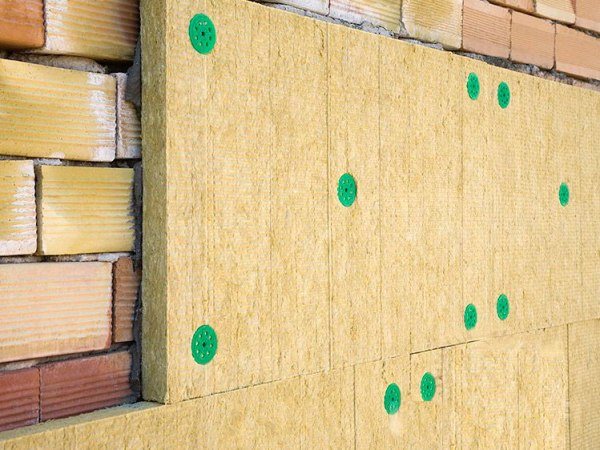

If you use a frame made of wood or metal, then the insulation is simply laid in the grooves of the frame. Fixing with dowels is also possible.
Wood floor insulation technology with mineral wool
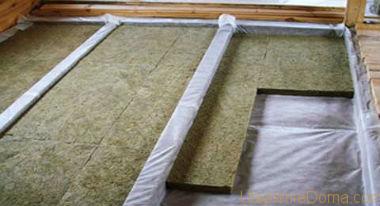

Waterproofing (membrane) is laid under the mineral wool.
A wooden floor is a board stuffed onto supporting rails. Bars or logs can be used as guides, which are placed either on posts or in special wall niches. Guides are placed on the posts only when erecting a floor on the first floor, and bars or logs fixed in the walls can also be an overlap between floors. The guides on both sides are sewn up with a board, which directly affects the method of floor insulation with mineral wool.The technology consists in placing thermal insulation in the voids between the subfloor and the final floor.
If the floor is laid on the interfloor ceiling, then the ceiling of the first floor will act as a rough covering. The board is stuffed directly onto the beams from below. If we are talking about the field of the first floor, then there are two methods of laying the rough covering:
- from below to the beams;
- on the bars fixed along the guides.
In the second case, the boards can not even be screwed on, which will allow, if necessary, to open the floor insulation layer with mineral wool with a little blood. Thermal insulation installation technology involves the use of protective films. If they are placed incorrectly, then moisture will collect in the insulation. To dry the mineral wool, it must at least be opened, which is much easier if the rough floor is easy to dismantle. Also read: "Insulation of the ceiling of a private house with mineral wool".
We have already said that there are two types of mineral wool for the floor - stone and glass wool. Despite the fact that these materials belong to the same group of fiber insulators, they have more differences than in common.


Glass wool is soft and lightweight.
What is the best mineral wool for the floor? - by a combination of factors (environmental friendliness, thermal conductivity, installation and operation features), clearly, glass wool. It is lighter, retains heat better, does not break and does not produce dust. For its production (many manufacturers, but not all) do not use phenol-formaldehyde resins.
To insulate the floor with mineral wool, you need two types of films:
- vapor barrier - does not allow steam and moisture to pass through;
- waterproofing - allows moisture to pass in one direction, does not allow steam to pass through at all. It is called a diffusion membrane.
The vapor barrier can be installed on either side, and the membrane must be installed correctly. The side where the drawing is applied should not come into contact with the insulation. The side that is rough or fleecy must fit into the insulation. The technique of floor insulation along the logs with mineral wool:
- rough coating;
- waterproofing (advertising down);
- glass wool;
- vapor barrier;
- clean floor.
It also happens that a screed is poured onto a wooden floor. In this case, thermal insulation work can also be carried out, which we will describe below.
An infrared gas heater for your home can be a great alternative to an electric one.
An overview of modern electric home heaters can be found at this link.
Wood floor work - installation tips
Thermal insulation of a wooden floor with mineral wool gives very good results. Fashionable wooden houses, log cabins also cannot do without insulation with this material. In order not to disturb the balance of naturalness of the wood floor, the insulation is also taken as environmentally friendly. No additional equipment is required to insulate the wooden floor.
- We remove the old boards and find logs under them, if you are insulating a new, newly built house, then we first carefully trample the soil and fill it with gravel with bonded bitumen.
- On this pillow, columns of bricks are installed, separated by two meters from each other, on which wooden logs are laid - they will be the basis.
- We attach a metal mesh to each lag from under the bottom, and already attach a windproof film to it, it will protect the insulation from being blown up by the wind. There will still be drafts under the house.


Insulation laying - Mineral wool is laid on this very film.
- You can buy mineral wool with a windproof coating at the bottom and not bother with stuffing the mesh.
- The next layer is a vapor barrier sheet. We tightly close each joint. You can replace the canvas with roofing glassine.
- Now it is the turn of the wooden floor itself. We lay the boards evenly, leaving no gaps between them and cover them with a decorative coating.
The thermal insulation properties of mineral wool are excellent! The chaotic interior of this material forms many air cavities, they do not allow the passage of radiation heat.
Laying mineral wool on a concrete floor


The method of laying mineral wool under the screed.
Concrete has a porous structure. It absorbs moisture like a sponge, and when it gets wet, it quickly freezes. Therefore, along with floor insulation with mineral wool in a private house, you need to do high-quality waterproofing. The solution is poured:
- on the ground;
- on a concrete floor;
- on a wooden floor.
In all cases, the laying of mineral wool on the floor is carried out in the same way. Only when pouring concrete over the ground, first you need to create a thin leveling layer of the screed. Method of work:
- waterproofing is laid (it is allowed to use materials with vapor barrier characteristics);
- mineral wool is placed for floor insulation;
- the second layer of waterproofing is spread;
- the main screed is poured.
A gas ceramic home heater works independently from any centralized networks. It can also be used for cooking, like a tile.
Read more about quartz heaters for an apartment here.
But in fact, mineral wool for the floor under the screed is rarely used, more often ordinary or extruded foam is used for this. Polymers are moisture resistant and easier to work with. At the same time, there is stone wool with a very high density (up to 225 kg / m3), which is produced specifically for laying under a layer of mortar. But for the price, not everyone can pull such insulation.
It is fully justified to use mineral wool when insulating a concrete floor along the logs. In this case, you can take low-density thermal insulation, moreover, it is cheaper. After the guide bars are fixed, the work is carried out according to the wood floor insulation scheme. Only in this case concrete will be used as a rough coating.
Today, a method has been developed for obtaining a special type of insulation - stone wool made from basalt. Twenty years ago, such mineral wool was used exclusively for the needs of the defense industry, and today this insulation is widely used for thermal insulation of any buildings.
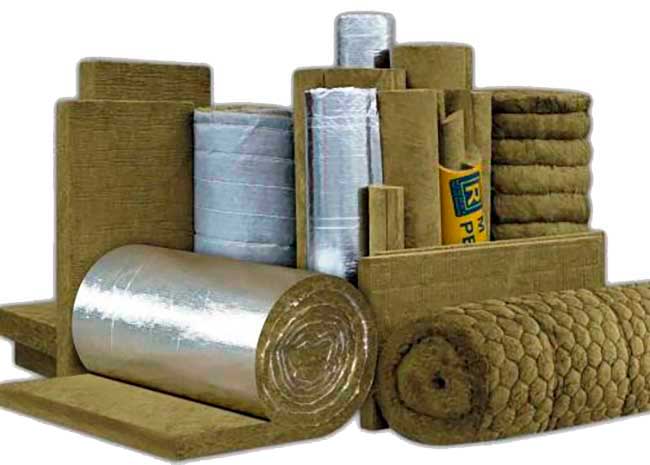

The composition of mineral wool does not contain such environmentally harmful components as acrylic and phenol-formaldehyde resins. It consists only of natural binders, therefore it is safe for humans. This heat-insulating material not only perfectly retains heat, but also allows you to create reliable sound insulation of premises. Basalt mineral wool is becoming more and more popular and has already been tested by time, but people still have a lot of questions regarding technological issues, which we will try to focus on in this article.
How to properly fix the mineral wool?
In this case, everything depends on the type of insulation and on the type of structure on which the insulation is mounted. Light grades of mineral wool are installed in frame structures in the spine. Rigid mineral wool boards are fixed with special dowels or fixed using special adhesives.
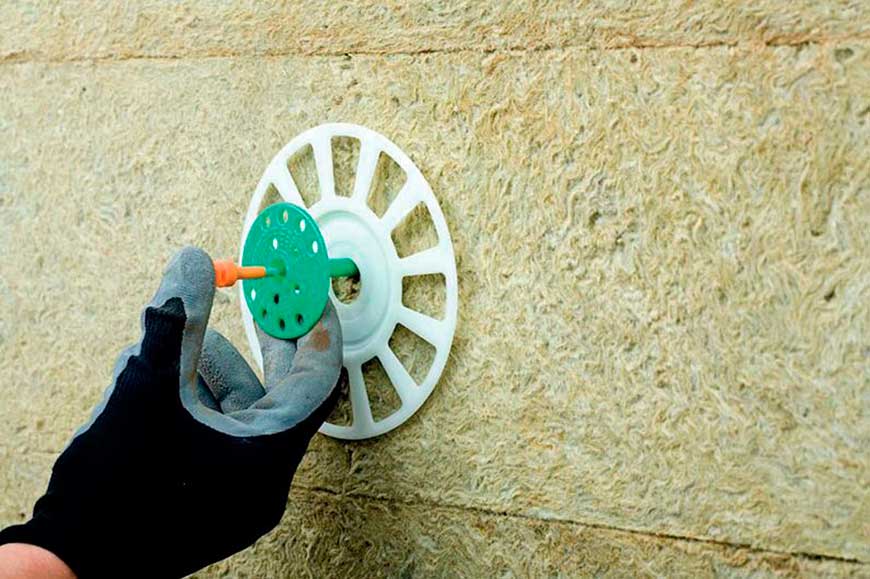

When fastening the raspor, mineral wool is placed very tightly in a wooden frame pre-assembled from slats and bars. The thickness of the frame must correspond to the thickness of the insulation. Between the slats, an interval less than the width of the mineral wool is maintained by 1.5-2 cm, which does not allow the material to slip during operation. The mats are mounted starting from the bottom of the structure, and the rolls from the top. In this case, the solid pieces are stacked first, and the free space, for example, near doors or windows, is filled later.
High density mineral wool is often installed without intermediate / support bars.It is completely wound up behind the frame and pressed against the supporting structure without a gap, after which, for safety reasons, it is fixed with dowels with a wide head, that is, the so-called "disc" dowels. In such a system, the frame elements are located on top of the insulating layer and press the cotton wool against the wall, in addition, the brackets that pass through the mats help keep the insulation in place.
When using the bonded thermal insulation method (wet method), frames are not used at all, therefore adhesives must be used as fastening. In this case, you will have to purchase a dry mixture, but always intended for gluing mineral wool insulation. Recently, polyurethane glue in cylinders has become more and more popular, which allows you to mount dense mineral wool to any bases, including wood, metal, polymer. This technology also involves the use of disc dowels. We considered in more detail the features of gluing insulation in the articles on adhesives and wet insulation of the facade.
What is the best way to cut mineral wool?
It is recommended to cut heat-insulating materials from stone wool with a hacksaw for metal or with a specially designed sharp long knife, the blade of which is serrated. In any case, the equipment should be well sharpened so that as few fibers are pulled out as possible. Many companies that produce insulation also offer their customers cutting tools: knives about 300 mm long, as well as saws with teeth without divorce, about 60 cm long.For the lack of special devices for such purposes, kitchen bread knives with small teeth show themselves well and wavy edge. Thin soft slabs and mats (50 mm) can be cut with a regular cutting knife.
Mineral wool produced in rolls is best cut before unrolling. And the mineral wool slabs are taken out of the packs and cut one by one. It should be remembered that when installing thermal insulation, the insulation must fill the entire insulated space very tightly, therefore, allowances should be left before cutting: for plates - 0.5 cm; and for mats - about 1-2 cm.
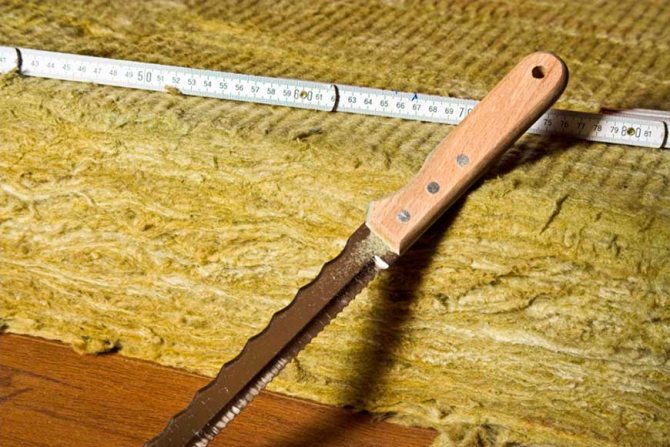

Is it true that mineral wool needs to be protected from moisture and wind?
During the operation of insulated buildings, their walls, roof and other structures should be protected from high atmospheric humidity and from being blown by strong winds. Therefore, after installation, the mineral wool insulation from the outside is covered with canvases made of a vapor-permeable moisture and windproof membrane. This allows you to prevent the penetration of cold wind and oblique rain drops into the thickness of the wall. At the same time, water vapor from the interior space, through diffusion passing through the walls, will be able to escape outside without obstacles.
The undoubted advantage of mineral wool is its vapor permeability, and this property should be used to the maximum. When installing mineral wool heat-insulating materials between the bearing wall and the insulation, it is not necessary to lay a vapor barrier, since such sealing will negatively affect the climate inside the building. The lack of artificial ventilation in this case will lead to an increase in humidity and the formation of condensation, which, in turn, will cause the formation of mold and mildew.
A vapor barrier film must be used when installing thermal insulation indoors - in this case, it is installed on the warm side of the mineral wool. This allows you to protect the insulation from water vapor from the premises. Reinforced polyethylene can be used as a vapor barrier, which is placed between the insulation and the cladding.
If the design allows, it is imperative to provide a ventilated air gap between the insulation and the external finish. This will help keep the mineral wool dry, while not reducing the vapor permeability of the building.
What if you need to use cotton wool in a layer of 15 or 20 cm, and the insulation is supplied with a thickness of 5 or 10 cm?
There is nothing complicated here. You need to calculate the required thickness using the formulas or using an online calculator (we talked about this in the last article), and then you can easily type an insulating barrier from several layers. In addition, this method allows you to easily eliminate the problem of the formation of cold bridges and blowing out the joints. To do this, when installing the insulation, the sheets of the outer and inner layers should be shifted relative to each other by 20-30 mm in order to reliably cover the seams.
Do I have to use protective equipment? What kind?
Mineral wool is considered a safe heat-insulating material, both during operation and during installation. However, with prolonged work with this insulation, it is better to protect yourself using personal protective equipment.
Stone wool, in comparison with glass wool, is much more convenient and safer to work with, but you should still be careful when installing it. It is best to work on cold days in an overalls made of dense fabric that covers the whole body from contact with mineral wool. It is not recommended to touch this material with bare hands; to protect them, you can use “glazier's gloves” - fabric with rubber or silicone dusting in the palm area. It is also imperative to protect the eyes and scalp. To protect the respiratory system, wear a respirator.


During the installation of stone wool, you should take a break to ventilate the room. Open packs of material must be shifted carefully, not allowing them to fall, so that microparticles do not stand out from them. During the installation of thermal insulation on the construction site, there must be no children or people who do not use protective equipment.
Are there any nuances in transportation and storage?
Mineral wool insulation should be stored in whole packages on a flat dry surface, the height of the stacks should not exceed 2 meters. Stacks are made in closed rooms protected from rain and moisture. If the mineral wool is stored outside, it must be covered with plastic wrap or tarpaulin.
Mats and insulation boards are transported horizontally in covered trucks. During transportation, the insulation must be protected from mechanical damage and precipitation. During loading / unloading and transportation, it is impossible to squeeze the material too much.
You need to unpack the mineral wool correctly. For this, the insulation is taken out of the package immediately before installation, which significantly reduces the risk of damage to the thermal insulation. Insulation packaging can be used on a construction site when laying out mineral wool (when you need to protect it from contamination), it is also suitable as bags for construction waste.
What is the best cotton wool?
There is no unequivocal answer to this question, since different types of material will be the best option in different conditions.
Basalt soft wool. It is used where high loads are not expected. This material can be used to insulate walls made using frame technology, as well as for thermal insulation of floors and roofs. The fact that cotton wool is soft does not mean at all that its performance is poor. It is simply produced from thin fibers, which ensures the presence of many cavities in the insulation, in which air is retained, which prevents heat loss.
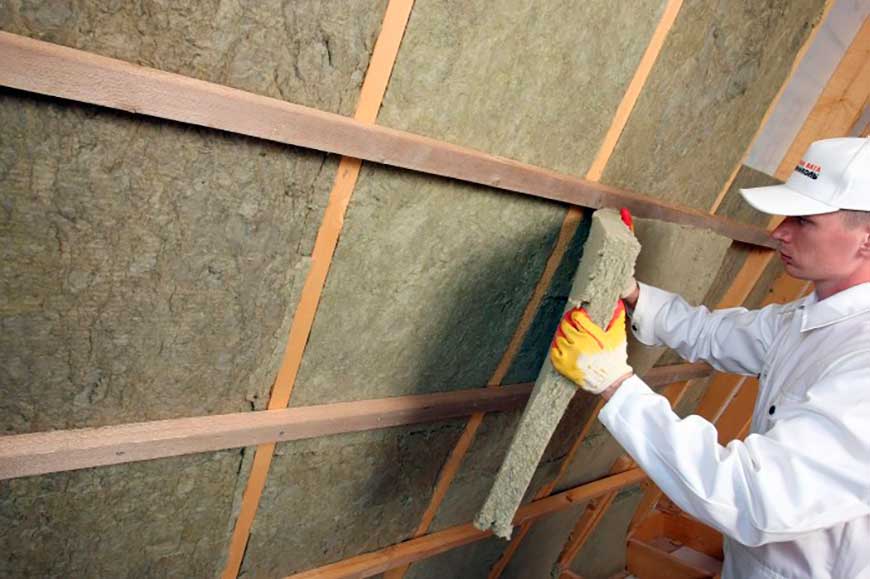

Mineral wool of medium hardness (density). It is used mainly for warming ventilated facades, where high-speed air flows are created in the air cavities. It is also used for fire-prevention measures, sound and heat insulation of ventilation channels. Medium density mineral wool can be installed without problems instead of soft basalt wool, but the cost of thermal insulation will be more expensive.
Rigid basalt wool.This insulation is used in places where high loads are possible on it. For example, where it is planned to insulate walls with reinforcement and plastering (wet method) or when creating some types of floors.
Cylindrical heaters for pipes. Usually they are produced with a diameter of more than 50 mm. They are slotted parts that you can unfold and slide over the pipe, or two-part models that connect on the pipe.
Foil basalt wool. This insulating material is characterized not only by low heat transfer, but also reflects heat, directing it inside the premises. Mineral wool can be covered with foil on one or both sides. When laying, the heat insulator is installed with the foil side to the heat source. The scope of this insulation is quite extensive, it is considered a universal material suitable for all methods and types of thermal insulation.
Sewing cotton wool. It is a very strong mats, one side of which is sheathed / reinforced with steel mesh (galvanized, stainless, fire-resistant, acid-resistant). The canvases can be of various thicknesses and can be used to perform various types of thermal insulation. Sewn wool is usually non-combustible, therefore it can be used to insulate surfaces with elevated temperatures (up to plus 660-700 degrees).
An important technical characteristic of mineral wool is its specific gravity. Insulation, the density of which is up to 75 kg per cubic meter, is ideal for thermal insulation of planes where the impact of heavy loads is not expected, for example, for laying in ceilings in attics and roofs. Basalt wool of low density is often used for wrapping pipes of heating plants, boilers and similar nodes / communications.
Stone wool, the density of which is up to 125 kg per cubic meter, holds its shape well and is great for insulating ceilings, walls inside buildings, and various vertical structures. It is used for thermal insulation of brick walls, as well as foam block or aerated concrete surfaces. Mineral wool of this specific density allows not only to insulate the building, but also to ensure its reliable sound insulation.


Basalt wool of high density - from 175 to 200 kg per cubic meter, is characterized, in addition, by increased rigidity, hence the abbreviation in its name (PPZh). Such insulation is used for thermal insulation of initially too cold planes - reinforced concrete, sheet metal. The PPZh-200 brand is also excellent for arranging additional protection of residential buildings from fire. Only high-density mineral wool can be installed using the technology of façade insulation with a wet method.
Outcomes
Glass wool is best suited for warming the floor with mineral wool on the logs, not basalt. The first is warmer, softer, more environmentally friendly and most importantly lighter. This reduces the load on the load-bearing beams, which are placed on specially erected posts or in wall niches. Steam and waterproofing must be used, since glass wool, when wet, ceases to retain heat. For insulation of a concrete floor under a screed, mineral wool is rarely used, basically everyone works with polystyrene. But in principle, high-density stone wool meets all technical requirements and can be used for this type of work.
Thermal insulation of the floor with mineral wool: step by step instructions
The main stages of work are as follows:
- Preparatory activities. They are carried out during major repairs and include the dismantling of the floor covering. It is worthwhile to act as carefully and carefully as possible if the coating will be reused (for example, if it is a high-quality parquet that is planned to be restored, or if the coating is in good condition and can be used for repairs in the country, etc.).If you intend to return the floor material (for example, laminate) to its place after replacing the insulation, you can mark its parts with chalk so that it is convenient to lay it after completion of work. After removing the floor covering, small debris and dust inevitably remain, which must be carefully removed so that the rough sub-floor is as clean as possible by the time work starts.
- Leveling the surface. This is necessary in order to ensure a snug fit of the insulation. If the base is uneven, the mineral wool layer will be unevenly distributed, and moisture will accumulate in the resulting voids, which will lead to deformation of the floor covering. The easiest way to level a concrete floor is with a screed, but other methods can be used at the discretion of the home owner. Very often, cracks are found in concrete, which must be carefully repaired before installing the heat-insulating material, otherwise the "cold" places will remain after major repairs. You should proceed directly to laying mineral wool only after the floor has completely dried, usually it takes from several days to several weeks.
- Laying the vapor barrier. After preparing the base, you can lay a polyethylene coating on it, which will protect it from excess moisture from below. The vapor barrier material is laid with an overlap on the walls, while it is necessary to take into account the height of the guides and the future layer of insulation. Today on the market you can find a lot of different vapor barrier materials, they all have their own characteristics, so before making a choice, you should consult with a specialist.
- Installation of guides. Installation of mineral wool on the logs is very simple and quick, you must first install the guides. It is important to correctly determine the distance between the lags, which will require a tape measure. The maximum step should not exceed one meter, in a small room the gaps should be less, but always the same. The lag fastening should be approached as responsibly as possible, they should be well fixed, there should be no gaps between the wall and the guides.
- Laying the heat-insulating layer. Directly the stage of installing mineral wool will also require some preparation: the material must first be cut into pieces, the length of which should correspond to the distance between the guides. It is very important that the mineral wool is tightly pressed against the guides without cracks and gaps. The easiest way to do this is to cut the insulation about 1 cm wider than the distance between the logs. Mineral wool is usually laid in one or two layers (the second option is appropriate when the height allows). A double layer of insulation provides reliable thermal protection, but it must be laid correctly: the middle of the pieces of material for the second layer should fit into the joints of the pieces of the first layer. This method will help to avoid the appearance of gaps between the pieces of insulation and prevent leaks.
- Laying the waterproofing layer. Since mineral wool is absorbent, it is necessary to take care of a high-quality waterproofing layer, especially at high humidity levels. Dense polyethylene is used as a waterproofing material, which reliably protects the insulation material from a humid environment.
- Laying the finished floor and flooring. To evenly distribute the load, the floor must be strong, otherwise the coating will sag under the weight of furniture and household appliances. It is best to use boards, chipboard or drywall, which are easily fixed with a screwdriver. After finishing the installation of the finished floor, you can lay any floor covering: tiles, laminate, linoleum, parquet and even carpet.
Do you need a vapor barrier when insulating a floor with mineral wool in an apartment?
The construction of a residential building or its renovation is a long-term work, the result of which should be quality.
Vapor barrier is a film that, together with other structural elements, interacts, stopping the formation of condensation. Usually people spend it during a major overhaul.
Hydro-vapor barrier helps to increase the operational life, because it prevents moisture from penetrating into the insulated layer.
In winter, vapor barrier is especially important, since the temperature in the room and outside is seriously different - this leads to the formation of steam in the house, which must leave the room without any obstacles. Basements, attic, first floor, interfloor partitions need steam isolation most of all.
The walls do not really need it if they are insulated from the outside. A sign of this may be that the surface is not breathable:
- surface covered with non-porous sheathing;
- a thick, continuous layer of waterproofing is applied;
- wall made of bricks.
There are other situations when a vapor barrier is not necessary. From all this, it can be concluded that walls, floors and ceilings insulated with mineral wool do not necessarily need protection against condensation. Vapor barrier is necessary only in cases where the room is in constant contact of a warm air flow with the surface.
Hydro-vapor barrier is one of the most important factors when insulating a residential building with mineral wool. This fence will help you to overcome the humidification of walls, floors or ceilings with condensation (transition of a substance from a gaseous to a liquid state) when warm air comes into contact with the surface.
One of the main advantages of a room's vapor barrier is that it can be done independently, without having any specific abilities and skills. But what is mineral wool? This article will consider this material intended for warming a room, the reason for the need for vapor barrier outside and inside the room.
How to choose stone wool?
Before buying insulation for a house or apartment, you need to determine how much material you need to purchase, as well as calculate the load that mineral stone wool will be subjected to. When insulating facades, stone wool is often used in slabs. For sound insulation of partitions, the material can be used both in sheets and in rolls.
Roll stone wool has a standard thickness of 5 mm, although sometimes there are options up to 10 cm thick. Stone wool, the size of the slab of which is 1x2 m, has a rectangular shape, but some manufacturers can produce mats of non-standard sizes. Cylindrical insulation used for pipes can have an inner diameter of 1.2 to 32.5 cm.The length of the roll is up to 1.2 m, and the thickness is 2-9 cm.
In order to securely glue the stone wool slabs, it is necessary to select the glue that will be optimally combined with the base material. For fastening such insulation as basalt mineral wool, two types of assembly compounds are used:
- Dry glue. It is diluted with water, applied to insulation and distributed with a comb. The most popular brands are EK Thermex, Ceresit CT 190.
- Foam. It is packed in cans. It is applied around the perimeter and in the center of the slab. The most popular foam is Insta STIK and Ceresit CT 84.
For those who decide to insulate a house or apartment with stone wool, experts recommend that you first study the manufacturers of this insulation. The best companies involved in the production of such material are:
- ROCKWOOL is a Danish company that is the undisputed world leader in the production of mineral wool. Rockwool stone wool is environmentally friendly, fireproof, does not shrink or crumble.
- Knauf is a German concern specializing in the production of building materials. Such mineral wool is easy to install and serves for a long time.
- Isover - the products of this company are distinguished by their durability and excellent value for money.
- Paroc is a Finnish manufacturer of environmentally friendly and weather-resistant basalt slabs.
- Ursa is a stone wool company with excellent heat and sound insulation properties.
Before purchasing stone wool, you need to find out the amount of material you need and calculate the load that will fall on the insulation.
We have already said that the prices for it are high, but you can still save money. The following factors will affect the cost:
- Density of cotton wool;
- Manufacturer;
- Binder and rock category;
- The presence of another coating layer;
- Purchased quantity.
When buying, be sure to look at the instructions, they usually indicate the scope of application of stone wool and its technical characteristics. The most proven ones are Technonikol and Rockwool. The last company is located in Denmark; the insulation materials from this country are of the highest quality, as there are strict certification bodies.
When choosing, check with the seller how the fibers are located: horizontally, vertically or in a chaotic manner. The first two types do not allow the material to deform, and the latter provides good heat and sound insulation.
Depending on the density, stone wool is usually divided into categories. Stone wool: slabs for walls:
- Brand P-75. Suitable for non-stressed horizontal interior surfaces for pipe insulation.
- Insulation for walls of cotton wool of the P-125 brand. Suitable for both horizontal and vertical surfaces. It is ideal for insulating ceilings, floors and interior walls.
- PZh-175. Stone insulation for walls made of metal profiled sheet or reinforced concrete.
- Insulation cotton wool PPZh-200. The toughest stone wool. This is used in engineering buildings, protecting them from fire.
We suggest that you familiarize yourself with: What can be done in the sauna
Warming a house with stone wool begins with the choice of the manufacturer.
Stone wool "ROCKWOOL" is popular both in the domestic and foreign markets. It has the following distinctive characteristics:
- Good level of strength;
- Mineral wool for wall insulation is 15 years old;
- The fibers are arranged in a chaotic manner;
- Helps save electricity as claimed by the manufacturer;
- An additional layer to increase moisture resistance.
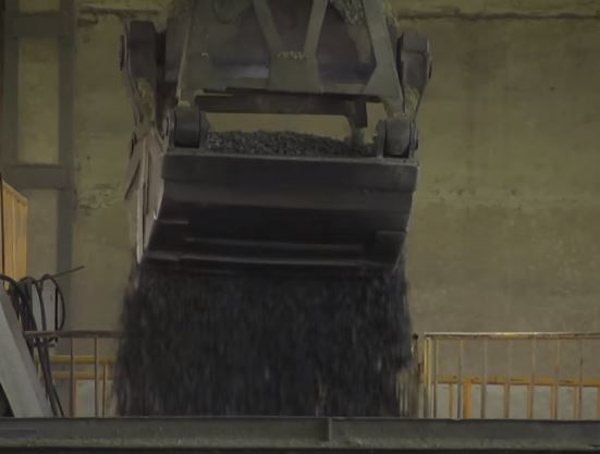

Stone wool "Technonikol".
- It is produced only on the basis of basalt rocks;
- Additional layer for noise reduction;
- Low weight for easy work.
Insulation for walls stone wool "URSA":
- Special packaging will make it easy to transport the material and work with it;
- Does not contain formaldehyde resins, therefore it is recommended for schools, hospitals, etc.
Selection Tips
Buying a truly high-quality product can be difficult at times. Therefore, it is imperative to know some important points.
- Pay attention to where and how the cotton wool is stored. Most often, it is stored in its original packaging and wrapped in shrink film. Make sure there are no holes or cuts on the packaging. Cotton wool should not be in the open air, but under a canopy.
- If stone wool is packed in cardboard boxes (they usually contain expensive insulation), then the place of its storage should be protected from moisture. Even after a little getting wet, it will not be usable.
- Purchase goods only from trusted sellers. Give preference to those stores that are located closer to you - this will reduce the cost of delivery.
Characteristics and indicators of stone wool
Thermal insulation with stone wool is attractive from the point of view of environmental friendliness and durability of the material. Resistance to high temperatures is also a plus. Basalt mineral fibers, for example, are kept under the "sight" of the flame for 3 hours.
True, bituminous binders evaporate already at 200 degrees. The material becomes looser. In case of further use, the insulation loses about 10% of its sound-insulating and heat-conducting properties, and may shrink.
The average vapor permeability of stone wool is 0.25 units. The indicator is measured in milligrams of water suspension passing through 1 square meter of insulation for an hour.
"Breathing" of stone wool eliminates the accumulation of condensation. This maintains a healthy indoor climate. Therefore, stone wool in the house is a welcome guest, like wood and stone in its usual form.
Stone wool can absorb water, but the maximum is limited to 3% for the area of the insulation. Mineral and glass threads do not absorb moisture at all. Basalt index is about 1.5%.
Like gypsum, stone fibers are able not only to absorb water, but also to give it away. The opposite process occurs when the surrounding atmosphere is dry.
The wide field of application of stone wool insulation is due to the unique properties and excellent characteristics of this material:
- Low thermal conductivity of stone wool. This material has a fibrous structure, which contains a lot of air, which is in a motionless state between randomly located filaments. The thermal conductivity of the air is very low and there is practically no convection (heat transfer), which leads to the excellent thermal insulation properties of stone wool.
- Fire safety. This is the most important advantage over all other heat insulators. After all, the base of the material does not burn, but only melts at temperatures above 1400 ° C. The fibers of the cotton wool are glued together with synthetic resins, which, when heated to 250 ° C, volatilize, but the threads retain their position. Thus, stone wool slabs and mats, while maintaining their geometry, prevent the spread of fire.
- Noise isolation. The chaotic arrangement of the fibers within the material suppresses sound and shock vibrations. Using stone wool to insulate walls or laying material on internal partitions, you can protect the room from noise both outside and from neighbors.
- Water vapor permeability. Stone wool treated with water repellents helps to remove excess moisture from the walls of the house. In addition, the likelihood of mold and dampness is reduced.
- Dimensional and shape stability. This insulation material does not cake or shrink. Thanks to this, no gaps appear at the joints between the slabs.
This insulation Therefore, stone wool ideally fulfills the task of thermoregulating a room. After all, it is able to retain heat in a room for a long time at a low external temperature and vice versa - not to transfer excessive heat to the room in the summer. The quality level of this property depends, first of all, on the components used during production.
Another positive aspect of stone wool is its resistance to fire. Therefore, this material is recommended to be used for houses with increased fire safety requirements. Stone wool can tolerate temperatures exceeding 1000 ° C without consequences, without losing its original properties.
The fiber itself can withstand such extreme temperatures, while the evaporation temperature of the binder is significantly inferior to the base material and is in the region of 200 ° C. Matrix material fumes can be hazardous to health to varying degrees, depending on the type of component used. The safest type of stone wool can be used to insulate the following types of buildings:
- offices;
- kindergartens;
- schools;
- medical institutions.
The material has several important properties that are indispensable for repair or construction.
- Thermal insulation.Insulating walls with stone wool is a great way to protect yourself from the cold in winter, and from the heat in the summer. The room temperature will be constantly adjusted. The effectiveness of this property depends on the components in the composition. It turned out that stone wool for wall insulation is the right solution.
- Not flammable. Even at temperatures above 1000˚C, stone wool does not ignite. Therefore, it belongs to safe materials, and, moreover, protects other flammable parts of the house, preventing the spread of fire. Although binders evaporate already at 200˚C.
- Permanent form. Due to this characteristic, cotton wool can withstand mechanical stress. This allows the use of stone wool for floors that are subject to stress at all times. The effectiveness depends on the selected binder.
- Soundproofing. Provides simple protection from street or neighborhood noise, as the fibers interfere with the propagation of sounds.
- Waterproof. Excess moisture in the room comes out without getting into the cotton wool. This property helps maintain optimal humidity. And no matter how humid the air is, stone wool always remains dry, and mold and other filth will not start on it.
- Environmental friendliness. During production and operation, the environment is not susceptible to negative influences.
Advantages and disadvantages
Mineral wool for insulation has the following advantages:
- Non-flammable;
- Waterproof;
- Stone wool - insulation for walls - has a wide range of operating temperatures;
- Eco-friendly;
- Safe during installation and operation;
- Good heat and sound insulation;
- It is easier to insulate something with stone wool than other materials.
Disadvantages:
- Insulating walls with cotton wool is a costly undertaking. Don't expect to buy cheap cotton wool. Low prices for it indicate that it contains a lot of impurities and low-quality material.
- Dust. The process of warming the walls of the house with stone wool is accompanied by an abundant amount of dust, especially if it is handled carelessly. For protection, it is advisable to take a respirator, although a regular mask from a pharmacy will do.

